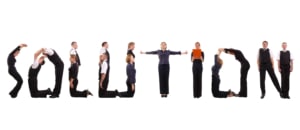As opposed to co-teaching, where teaching responsibilities are often shared between two colleagues, the teacher-paraprofessional relationship is a bit different, with the teacher taking more of a supervisory role. This can influence attitudes that are reflected in phrases like “just a paraprofessional,” when paras actually play a much more important role in the classroom than many realize.
The secret to getting the most from a paraprofessional is in building a positive, communication-rich relationship. It’s important to realize that the relationship between a teacher and paraprofessional is just that: a relationship—with two people, two sets of opinions and, often times, two teaching philosophies. Sometimes the personalities gel, and sometimes they take time to build trust, a comfort level, and a smooth working relationship.
 Paras can be much more effectively utilized in inclusive classes than they often are. Many of the strategies used in co-teaching to bring the best out in each other can also be used effectively in developing a relationship with a paraprofessional. This is not to say that the outcomes will be the same as co-teaching, particularly in special education, but teachers can better realize and use a talented para’s skills in the classroom setting.
Paras can be much more effectively utilized in inclusive classes than they often are. Many of the strategies used in co-teaching to bring the best out in each other can also be used effectively in developing a relationship with a paraprofessional. This is not to say that the outcomes will be the same as co-teaching, particularly in special education, but teachers can better realize and use a talented para’s skills in the classroom setting.
Ways for teachers and paraprofessionals to build a positive relationship:
Teachers:
- Consider the paraprofessional an essential member of your teaching team. Whenever possible, include the paraprofessional in planning, team meetings, troubleshooting, and any other decision where you feel input from the paraprofessional would be valuable.
- Discuss issues with your paraprofessional, especially when the issue is related to the student he or she is working with. Oftentimes, a paraprofessional has an outside view that teachers tend to miss.
- Empower the paraprofessional to monitor behavior and support the discipline process in the classroom. This empowerment will be well worth it when you must leave the classroom with a substitute, knowing that you have challenging students in the room.
- Provide the paraprofessional with lesson plans, activities, or “to do” items as early as possible. Last minute rushes tend to stress both the teacher and the paraprofessional and don’t allow for proper preparation time.
Paraprofessionals:
- Ensure that you are a team player. Share insights and solutions that you gain from being another set of eyes in the classroom. Be careful not to undermine the team effort by going in a different direction than planned.
- Honor the teacher’s classroom management style. Mirror it unless it violates your values. If it’s a style you are not comfortable with, try to discuss positive solutions.
- Take notes and document them on easy-to-remember forms so that they can be referred to throughout the year. This is critical for paraprofessionals who are working with more than one teacher because each teacher may have different expectations.
Communication is critical, not only to the success of the students in the classroom, but also to the collaborative relationship. Both teacher and paraprofessional can improve on their communications with each other, set and follow expectations, and discuss issues frequently. This way, they can keep lessons on track and quickly resolve miscommunications or misunderstandings.

Bring Susan to your campus!
Featured seminar – Paraprofessionals And Teachers Working Together in the General Classroom

